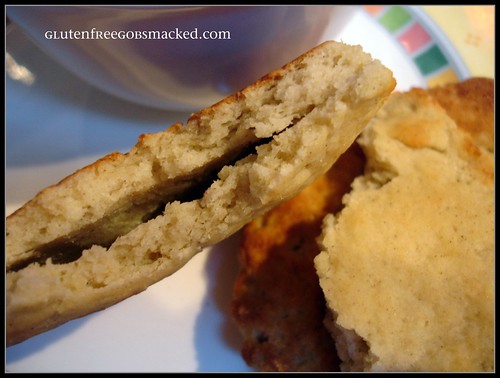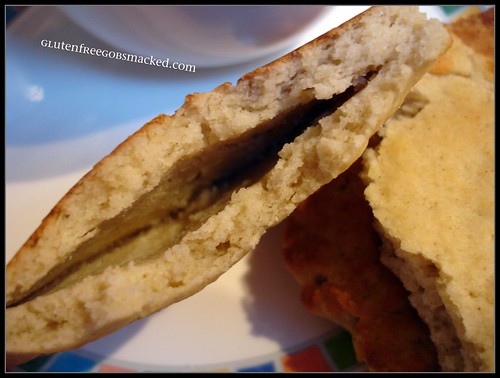GF: Homemade pita bread & hummus
Yes, I’m alive. Just swamped with paperwork and finals. Semester exams are next week. That means late nights of grading papers and exams and early mornings of meeting students for help. It’s a hectic time of year.
Being gluten-free during these long winter days means even later nights of baking bread or putting together lunches. Sometimes I stay up late baking because it helps me unwind from the day. Last night, for example, I was up grading papers and finally finished at 12:20AM (I started at 7:00PM!). I wasn’t quite tired enough to go to bed just yet – after all, grading is tedious work but not physically exhausting. So, last night I packed my lunch. A great bento box of Singapore noodles (curried rice noodles with vegetables, chicken and shrimp). Oh, yea – that was good!
Bento boxes are a great way to pack a gluten-free lunch for me. First of all, I can pack things in a small divided container (which is perfect for bringing a sandwich, carrot sticks, etc to work in an easy-to-carry container). I can also pack more elaborately in a Mr. Bento, a larger bento with multiple layers. I use the large bentos for days when I know I will be at work for 12+ hours and not able to get home for dinner. I can pack my lunch plus a snack for mid-afternoon. It’s perfect.
I’ve written a little about bento boxes before. I love the egg-molds you can use to make little cars, etc out of hard-boiled eggs. There are some great resources for bento boxes. Check out CookingCute.com for great pictures and ideas for lunches. The best part? The lunches you pack are limitless in ideas. No, not all of her ideas are gluten-free, but it’s great fun to see what everyone packs (Check out this flickr group. And this one. And dont’ stop there because there are many more!) – not to mention how creative the packing is! Check out these flickr photo groups for ideas and inspiration.
If you have a bento and are in need of tips to take care of the one you have, “Biggie” from “Lunch in a Box” has recently posted an awesome “How to Care for your Bento” post that I highly recommend.
So this weekend on a stress-reliever baking expedition, I stepped in to the kitchen and made some tasty thick hummus with chili oil and what does a good hummus need? Why homemade pitas, of course! Taking inspiration from Bette Hagman’s bread book, I made some fabulous mini-pitas that I used in my bento lunch yesterday with chicken salad. (Eating was primary on my mind yesterday, not picture taking – so you are left with just a photo of the pita. lol)
Here’s the modified recipe for you to make your own adaptations and twists too. A hummus recipe? Oh! There are some great ones out there. Please know that you can vary your hummus ingredients easily, only adjusting the amount of liquids you add. We love a thicker hummus than most (although I prefer it a bit thinner than the photo shows but my love likes it thick.) Hummus is EASY to make, doesn’t require exact measurements (please, it’s almost better if you don’t! LOL) But there are a few basics. Here’s a picture of the thick hummus I made for my love.
GF Hummus at Home!
Ingredients:
1 can garbanzo beans, rinsed and drained
2-3 Tablespoons lemon juice
2 – 3 Tablespoons tahini (sesame paste)
2-3 cloves of garlic
1/2 – 1 teaspoons salt
1 teaspoon cumin
1/2 teaspoon freshly ground pepper
other seasonings to taste, like: rosemary, roasted red pepper, roasted red onions, etc.
water – add by the Tablespoon until desired consistency – up to 1/3 cup (I didn’t add any water to the one above)
Directions:
- Add all ingredients to a food processor and grind for several minutes until smooth.
- Serve with pita bread, corn chips, on sandwiches, on burgers, etc.
I actually used a teeny squirt of agave in ours because the tahini tasted a bit more bitter to me than our regular brand. I only added a teeny bit and my love still gobbled it down (even though he is NOT the sweet-eater at all). See? Easy to adapt and hard to screw up = perfect food.
Here are a few more hummus recipes to get you started. Once you start making and eating homemade hummus, you will never shell out the $4+ dollars for the teeny tub at the grocer again. 🙂
- Basic hummus from Elyse at Simply Recipes
- Everything you ever wanted to know about hummus (and more, I’m sure)
- Green Pea Hummus from Sea at Book of Yum. Yea babe! YUM, indeed!
But now for the yummy bread.

GF Pita Bread
Makes 8 -10 pitas, depending on size
Ingredients:
2/3 cup sorghum flour
1/3 cup amaranth flour
1/3 cup rice flour
2/3 cup tapioca flour
2 teaspoons xanthan gum
1 teaspoon gelatin
3 Tablespoons almond meal
1/2 teaspoon salt
2 1/2 Tablespoons sugar
-YEAST PROOFING INGREDIENTS (to be added when “wet” ingredients are added)
1 1/2 Tablespoons yeast
1/2 cup warm water
1 1/2 teaspoons agave nectar (or honey)
-OTHER WET INGREDIENTS (not to be included while proofing)
2 eggs
1/4 hot water
2 Tablespoons butter, melted
Directions:
- Proof yeast with agave and warm water. Set aside until quite foamy (3-5 minutes) and while you get the dry ingredients ready.
- Add all dry ingredients (sorghum flour through first sugar listed) to mixing bowl and stir together to distribute well.
- Heat remaining 1/4 cup of water and add 2 Tablespoons of butter and stir until the butter melts.
- Add eggs, hot water/butter and proofed yeast mixture to dry ingredients. Stir until dough comes together. The dough will be somewhat sticky.
- Preheat oven to 500F.
- Prepare baking sheets by covering them with a silpat or parchment paper.
- Grease or oil hands. Take a piece of dough about the size of an egg, and shape it into your pita – about 1/4″ thick and 4-5″ wide/round. Lay the shaped pita on to the parchment or silpat. Repeat until all dough has been shaped.
- Let pitas rise in a warm place for 30-45 minutes. (I have a relatively cool kitchen, so I preheat the oven to heat the kitchen a bit more and then put the bread under a plant light indirectly during rising.)
- Once the pitas have risen, bake for 5-6 minutes in a 500F oven. The pitas may slightly brown but will not rise significantly.
- Allow pitas to cool on a cookie rack until they can be handled. (Cut into the pita to make a pocket when you want to use it.)
- Store in an air-tight container on the counter until you’ve used them all. And if you are making hummus, that won’t be long!
Happy eating!
-Kate

